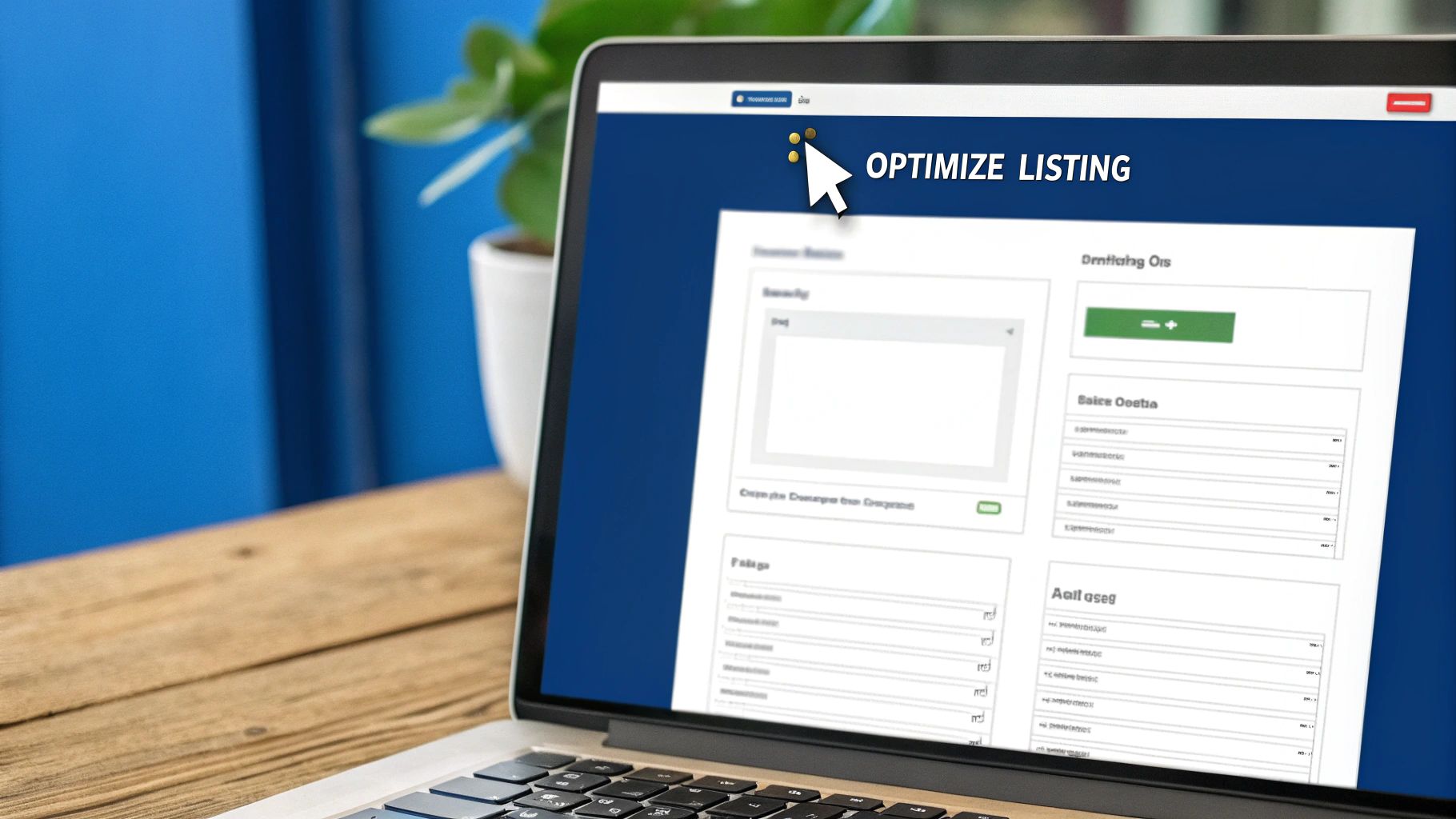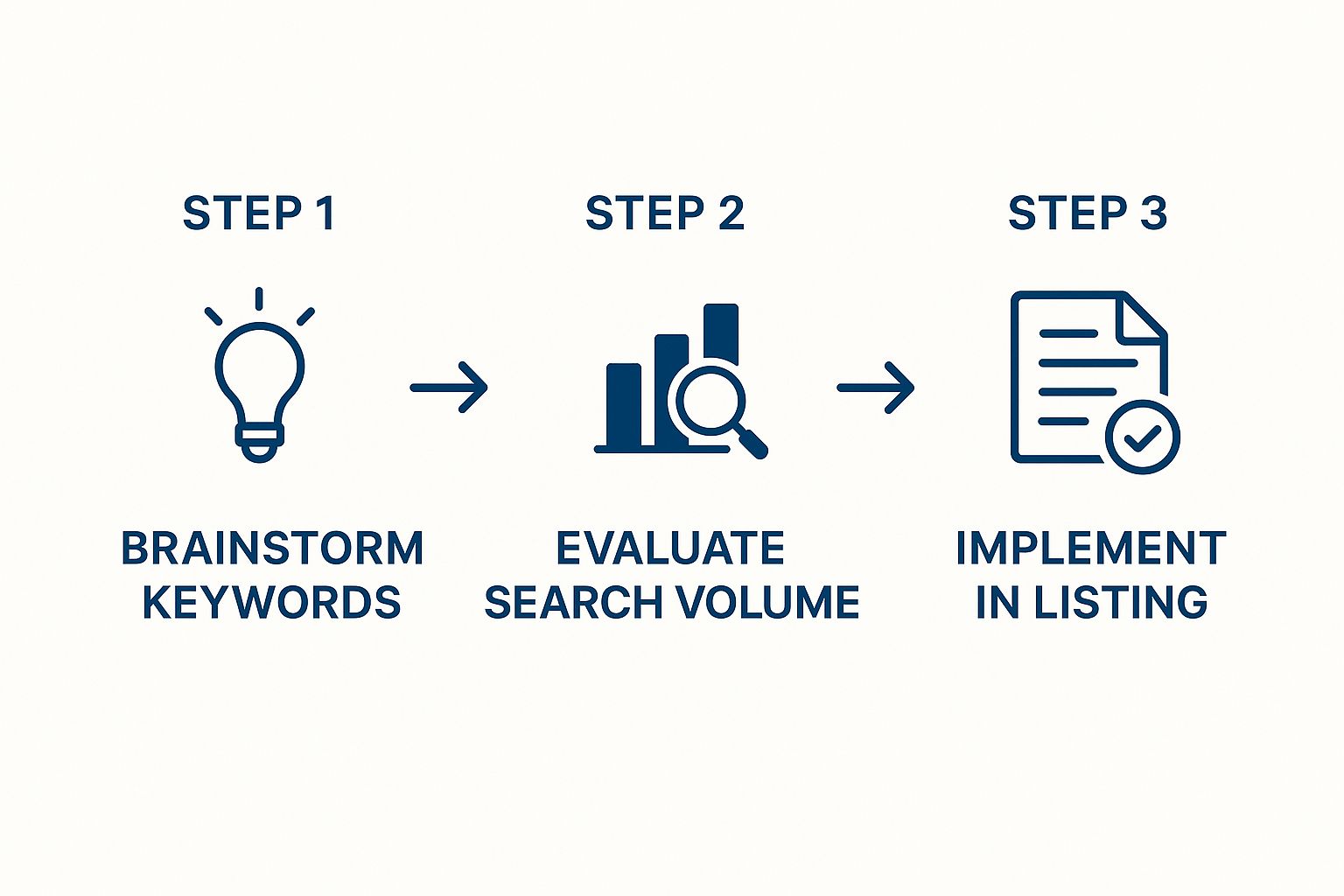How to Use Amazon Listing Keywords to Drive Profitable Growth
Unlock higher sales with our guide to Amazon listing keywords. Learn data-backed strategies for research, optimization, and PPC to boost your rankings.

When we talk about Amazon keywords, we’re not just talking about search terms. We're talking about the precise language customers use to find and buy products. A winning strategy isn't about getting seen; it's about attracting profitable traffic that converts. That’s the key to dominating the A10 algorithm, which prioritizes sales velocity above all else.
Rethinking Your Amazon Keyword Strategy

Too many brands treat Amazon keywords like a simple SEO checklist. The goal becomes ranking for the highest-volume search terms, a strategy that completely misses the most critical metric on Amazon: profitability.
Sure, you can pour ad spend into broad, competitive keywords to inflate traffic numbers. But if those clicks don't lead to sales, you're just paying Amazon to learn that your product is irrelevant for those searches. Each failed conversion actively works against you.
This is a crucial distinction. Amazon's A10 algorithm doesn't just reward visibility—it rewards sales velocity and conversion history for specific keywords. Think of it this way: every sale from a specific keyword is a "vote" that tells Amazon your product is the right answer for that search. The more votes you accumulate, the higher your organic rank climbs, creating a powerful, self-sustaining growth loop where your ad spend directly fuels organic sales.
The Shift From Traffic to Profit
For 2025 and beyond, the A10 algorithm is doubling down on sales velocity and conversion history. This makes a performance-first keyword strategy non-negotiable for brands seeking sustainable growth. Simply stuffing listings with high-traffic keywords is a recipe for wasted ad spend and stagnant organic rank.
This performance-first mentality requires a fundamental shift: trade the shotgun approach for a surgical one, zeroing in on keywords that signal strong buying intent.
For a clearer picture, let's look at the data:
- High-Volume, Low-Intent Keywords: A generic term like "water bottle" might see 100,000+ monthly searches. However, the intent is vague, attracting shoppers with wildly different needs (size, material, price). Conversion rates on these terms are often below 5%, and CPCs can exceed $3.00, making profitability nearly impossible.
- Lower-Volume, High-Intent Keywords: A specific phrase like "32 oz insulated water bottle with straw lid" gets far fewer searches but captures a customer who knows exactly what they want. Conversion rates for these long-tail terms can often surpass 15-20%, with more efficient ad spend and much stronger ranking signals sent to Amazon.
If you’re new to this concept, it helps to brush up on the fundamentals of What is Search Engine Optimization. Understanding the core principles of search will clarify why user intent and relevance are so powerful.
Keyword Strategy Shift From Traffic to Profit
The table below breaks down the outdated mindset versus the modern, profit-driven approach that wins on today's Amazon.
| Metric | Outdated Approach (Traffic-Focused) | Modern Approach (Profit-Focused) |
|---|---|---|
| Primary Goal | Maximize impressions and clicks | Maximize conversions and sales velocity |
| Keyword Selection | Broad, high-volume, generic terms | Specific, long-tail, high-intent phrases |
| PPC Strategy | Bid high on top-of-funnel keywords | Target converting keywords to fuel organic rank |
| Success Metric | High search rank for vanity terms | Profitability (TACoS) and organic sales growth |
| Algorithm Signal | "This product gets a lot of clicks." | "This product sells for this search." |
Ultimately, the goal is to align your strategy with what Amazon's algorithm rewards: products that sell consistently for specific customer searches.
Key Takeaway: Stop measuring your keyword strategy by search volume. The real objective is to identify and dominate keywords that drive profitable conversions. This approach aligns your advertising with Amazon’s algorithm, turning PPC spend into a direct lever for organic growth and sustainable scale.
This guide will walk you through building and executing a keyword strategy that moves beyond vanity metrics to deliver tangible results.
How to Build Your Foundational Keyword List

A profitable keyword strategy isn’t pulled from a single tool. It's built methodically, starting with a deep understanding of your product, your market, and—most importantly—your customer's mindset.
The goal isn't just chasing search volume. It's about creating a comprehensive universe of amazon listing keywords that capture how real people shop. This foundational list becomes your playbook for listing copy, backend search terms, and PPC campaigns. Getting this right from day one prevents wasted ad spend and accelerates your path to organic visibility.
Start with Seed Keywords and Good Old-Fashioned Brainstorming
Before opening any software, put yourself in your customer’s shoes. What are the most direct, obvious terms they would type into Amazon to find your product? These are your seed keywords.
Let's say you're selling a leather messenger bag. Your seed keywords are:
- "leather messenger bag"
- "men's shoulder bag"
- "laptop briefcase"
From there, brainstorm every related attribute, use case, and benefit. What problems does it solve? What features make it stand out? This manual first step is vital because it grounds your strategy in product knowledge and customer pain points, not just abstract data.
Dig for Gold in Customer Reviews
Your best keyword ideas are hiding in plain sight: your customers' own words. Scour the reviews for your products and your top competitors. Hunt for patterns in how people describe the product, its use cases, and any problems they mention.
Do customers consistently praise how their "15-inch MacBook Pro" fits perfectly? That’s a high-intent, long-tail keyword. Do they call it a "vintage crossbody satchel"? Add it to your list. This is how you discover the natural language your audience uses, which almost always converts better than sterile, corporate jargon.
Pro Tip: Don't just scan the 5-star reviews. The 1- and 2-star reviews are a goldmine for identifying pain points. If a competitor's review says, "The strap isn't adjustable," and yours is, you’ve just found a high-value keyword like "messenger bag with adjustable strap" that highlights a key competitive advantage.
Use the Amazon Search Bar as Your Crystal Ball
Amazon’s search bar is a direct window into shopper behavior. As you type your seed keywords, pay close attention to the auto-suggested phrases. This isn't a random list; it's a real-time feed of the most popular related searches.
This simple tactic is brilliant for uncovering valuable long-tail keywords. Typing "leather messenger bag for" might autocomplete with:
- "leather messenger bag for men"
- "leather messenger bag for women laptop"
- "leather messenger bag for school"
Each suggestion is a proven query from a real shopper. Add all relevant terms to your list. For a deeper look at this discovery process, check out our guide on finding the top Amazon keywords that can really move the needle.
Give Your Keyword Universe Some Structure
Now that you have a raw list of terms, it's time for strategic organization. A messy list is unusable. We recommend grouping keywords into three core categories to guide implementation.
| Keyword Category | Description | Example (for a messenger bag) |
|---|---|---|
| Primary (Core) Keywords | Broad, high-volume terms central to your product. Non-negotiable for your title and top bullet points. | "leather messenger bag" |
| Secondary Keywords | More specific phrases calling out key features, benefits, or your target audience. Great for bullet points and descriptions. | "crossbody bag for 15-inch laptop" |
| Long-Tail Keywords | Hyper-specific, multi-word phrases signaling high purchase intent. Perfect for PPC campaigns and backend search terms. | "vintage brown leather satchel with adjustable strap" |
By organizing your list this way, you've turned it into a strategic asset. You now have a clear roadmap for deploying the right keywords in the right places, from your product page to your ad campaigns. This foundational work makes every subsequent step more effective.
Tapping Into Your Competitors' Keyword Goldmine

Your foundational keyword list is a strong start, but it’s limited by your own perspective. The real breakthrough comes when you stop guessing and start analyzing what’s already working for the top sellers in your category.
Your competitors have already spent thousands in ad dollars figuring out which Amazon listing keywords convert into sales. They’ve essentially created a data-rich roadmap for you. All you have to do is learn how to read it.
This is where a Reverse ASIN lookup becomes one of the most powerful plays in the Amazon seller's book. Instead of starting with a keyword to find products, you start with a competitor's product ASIN and reverse-engineer every keyword they rank for—both organically and through paid ads.
This flips the script on traditional research. You’re no longer operating on assumptions; you're making decisions based on proven, real-world performance data.
How to Run a Tactical Reverse ASIN Search
Tools like Helium 10's Cerebro are built for this type of surgical analysis. The process is simple: plug in your ASIN and the ASINs of your top competitors, and the tool reveals a comprehensive list of the keywords they are ranking for.
Of course, the raw data can be overwhelming. The skill is in filtering this information to find actionable opportunities. You're not just building a list; you're hunting for strategic gaps in your competitors' strategy.

With a filtered view, you can see everything from search volume to the number of competing products, plus exact competitor rank. This context is critical for prioritization.
You’ll quickly spot keywords where multiple competitors rank well—these are almost certainly high-relevance, high-conversion terms. But the real gold is finding keywords where a competitor is on page one, and you're nowhere to be found. Those are your immediate targets.
Finding and Exploiting the Gaps
Your mission is to find high-opportunity keywords: terms with meaningful search volume but manageable competition. A great sweet spot for many products is a monthly search volume between 500 and 5,000.
Here’s a practical filtering strategy to pinpoint these gems:
- Search Volume: Set a minimum of 500 and a max of 5,000 monthly searches. This eliminates hyper-competitive head terms and low-traffic phrases.
- Competitor Organic Rank: Filter for keywords where top rivals have a strong rank (between 1 and 15). This proves the term converts.
- My Organic Rank: This is the key. Filter for where your product’s rank is 30+ or unranked. This is the opportunity gap.
- Competing Products: A lower count often signals a less crowded field for that specific search, making it easier to gain traction.
This process transforms a massive spreadsheet into a focused list of high-priority keywords. These are the terms to immediately integrate into your listing and target with focused PPC campaigns to get the flywheel spinning.
Key Takeaway: Your competitors have already done the heavy lifting. Use a Reverse ASIN lookup to see the exact keywords driving their sales. Zero in on terms in the 500-5,000 monthly search range where they rank well and you don't. This is the fastest way to find profitable gaps and start stealing market share.
Placing Keywords for Maximum Impact
You’ve built a powerful, data-backed list of amazon listing keywords. Now comes the critical step: strategic implementation. A perfect keyword list is useless in a spreadsheet; its value is only realized when woven intelligently into your Amazon listing.
This isn't about keyword stuffing. It's a strategic process of communicating relevance to both Amazon's A10 algorithm and the human shopper you're trying to convert.
Think of your listing as prime real estate. Each section—title, bullet points, backend fields—carries different SEO weight. Your goal is to place your most valuable keywords in the highest-impact locations to signal relevance to Amazon and compel a customer to click "Add to Cart."

As you can see, implementation is where the strategy comes to life.
Your Title: The SEO Heavyweight
Let's be clear: your product title is the single most important on-page ranking factor. It carries more weight with Amazon's search algorithm than any other field.
This is where your top 1-3 primary keywords must go, placed as close to the beginning as possible without sacrificing readability. Both shoppers and the algorithm scan the first few words to determine relevance.
A title like "Leather Messenger Bag for Men - Fits 15-Inch Laptop" is far more effective than "Stylish Bag for Work and School - Genuine Leather." The first one instantly matches the core terms people are searching for. The second is vague and fails to capture high-intent traffic.
Bullet Points: Where Features Meet Benefits
Your bullet points are your next most valuable SEO real estate. This is the perfect place for secondary keywords and more specific long-tail phrases. The key is to integrate them naturally by translating features into compelling, problem-solving benefits.
It's the difference between what your product is and what it does for the customer.
- Weak: "Made with genuine full-grain leather."
- Strong: "Durable Full-Grain Leather Construction: Enjoy a timeless vintage look that develops a unique patina over time, built to withstand daily use for years."
The second example seamlessly integrates keywords like "full-grain leather" and "vintage" while selling the customer on the value. It improves your ranking potential and your conversion rate.
Product Description & A+ Content
While the standard product description carries less SEO weight than the title or bullets, it is still indexed by Amazon. This is your opportunity to tell a richer brand story, answer common questions, and sprinkle in remaining long-tail keywords that didn’t fit naturally elsewhere.
For brands with A+ Content, there's a hidden advantage. While text within images isn't indexed, the alt-text behind those images is. This is a frequently overlooked spot to reinforce your most important keywords.
Our Take: Think hierarchically. Your absolute must-rank, high-volume keywords belong in the title. Your supporting, benefit-driven keywords go in the bullets. Everything else can flesh out the description and A+ Content alt-text.
The Hidden Power of Backend Keywords
"What about all the other keywords I found—synonyms, common misspellings, Spanish terms?"
That's precisely what your backend search terms are for.
These keywords are invisible to shoppers but are read directly by the A10 algorithm. This is where you place all relevant terms that would look awkward or spammy on the front end of your listing.
Use this space wisely:
- Use spaces, not commas: Separate terms with a single space for maximum efficiency.
- Don't repeat yourself: If a keyword is already in your title or bullets, adding it here is redundant and wastes valuable space.
- Stay in your lane: Never use competitor brand names. It’s a violation of Amazon's policy that can lead to listing suppression.
Getting keyword placement right is crucial for driving traffic. But traffic is useless if it doesn't convert. All this work goes hand-in-hand with improving your conversion rates. Turning clicks into customers is the most powerful signal you can send to Amazon's algorithm.
This blueprint will help you visualize where everything goes when building or optimizing a listing.
Keyword Placement Blueprint
| Listing Section | Primary Keyword Focus | Secondary & Long-Tail Focus |
|---|---|---|
| Title | Your top 1-3 highest-volume, most relevant keywords. Placed near the beginning for maximum weight. | Key product spec or benefit (e.g., "15-Inch Laptop Sleeve"). |
| Bullet Points | Reinforce primary keywords in a natural, benefit-driven context. | Weave in secondary and long-tail phrases that explain features and solve customer problems. |
| Description | Use primary terms again in narrative, storytelling sentences. | Ideal for longer, question-based keywords (e.g., "how to clean leather bag"). |
| A+ Content Alt-Text | Reinforce your absolute most important 1-2 keywords for each image. | Use synonyms and variations of keywords used in the bullets and description. |
| Backend Search Terms | Synonyms, common misspellings, foreign language terms (e.g., "bolso de cuero"), and related search terms. | Any relevant keywords you couldn't fit naturally on the front end of the listing. |
Following this structure ensures you are communicating maximum relevance to both the algorithm and your customers.
Using PPC to Fast-Track Your Organic Keyword Rank
Viewing Amazon PPC as just an advertising expense is a strategic error. For growth-focused brands, PPC is the single most effective investment for validating converting keywords and accelerating organic rank. It’s the engine that powers the flywheel.
The concept is simple but the impact is profound. Every time you generate a sale from a PPC ad tied to a specific keyword, you send a powerful signal to the A10 algorithm. You are effectively proving: "When a shopper searches for this phrase, my product is the best solution."
Amazon rewards this demonstrated relevance with a boost in organic ranking for that same search term. Higher organic visibility leads to more organic sales, which further solidifies your rank. This is how you transform ad spend into a long-term, compounding asset.
Let Auto Campaigns Do the Discovery Work
The first move is to leverage Amazon's own data. A well-managed automatic PPC campaign is your secret weapon for discovering keywords you’d never find on your own. Don't set it and forget it; treat it as a data-collection machine.
In an auto campaign, Amazon matches your product to a wide array of search terms it deems relevant. Your job is to let it run long enough to gather statistically significant data. After a few weeks, your Search Term Report will be filled with the actual phrases customers used just before buying your product.
This isn't theoretical data from a third-party tool; it's a direct report from Amazon showing you which search terms have the highest purchase intent for your specific product.
"Graduating" Keywords from Auto to Manual Campaigns
Once you've identified high-performing search terms in your reports, it's time to take control. "Graduate" these proven keywords into their own manual campaign.
This accomplishes two critical goals:
- You Control the Bids: In a manual campaign, you can set precise bids for each keyword, allowing you to be more aggressive in winning top-of-search placement and driving sales velocity.
- You Isolate Performance: By moving a keyword to a manual campaign, you should also add it as a negative exact match in the original auto campaign. This prevents them from competing and ensures your budget is deployed with maximum precision.
This systematic process—discover in auto, prove and scale in manual—creates a clean, data-driven pipeline for identifying and capitalizing on your most profitable keywords.
See the Flywheel in Action: Imagine strong PPC sales for "vintage leather satchel" tell the A10 algorithm your product is a great match for that search. What happens next? Your organic rank for "vintage leather satchel" starts to climb. This new organic visibility drives even more sales, which solidifies your rank and makes you less dependent on paid ads for that term over time.
Closing the Loop: Update Your Listing
This is the final, crucial step that many brands miss. Bidding on a keyword is not enough. To truly accelerate the flywheel, you must integrate these proven, high-converting keywords back into your product listing.
If your PPC data shows "messenger bag with trolley sleeve" converts at an incredible 15%, but that phrase is absent from your title or bullets, you are leaving organic rank and sales on the table.
Go back and strategically update your listing. The top performers should be added to your title or high in your bullet points. When you align your paid advertising with your on-page SEO, you create a powerful synergy that confirms relevance to the algorithm from all angles, multiplying the ranking benefits from your ad spend.
This process transforms PPC from a sales channel into a core growth system. To dive deeper into the data, our guide on analyzing search terms on Amazon is an excellent next step. By directly linking ad performance to your organic strategy, you build a durable competitive advantage.
Our Recommendation
Treat your PPC Search Term Report as your single most valuable source of keyword intelligence. Establish a disciplined, weekly routine of reviewing this report. Identify new high-converting terms, graduate them to manual campaigns, and immediately update your product listing. This constant feedback loop is the key to turning your ad budget into an engine for unstoppable organic growth.
Answering Your Lingering Amazon Keyword Questions
Even with a solid plan, a few nagging questions can slow you down. Let's clear up some of the most common things we hear from sellers about their Amazon listing keywords so you can move forward with total confidence.
How Often Should I Mess With My Keywords?
Keyword optimization isn't a one-and-done job. Think of it more like regular maintenance. The market changes, new competitors show up, and the way customers search for things is always shifting.
As a general rule, you should plan on doing a full keyword audit and refresh at least once every quarter.
That said, some things should make you drop everything and take a look right away:
- A sudden drop in performance: If your sales or traffic take a nosedive, your keywords are one of the first places to check.
- You've updated your product: Changed a feature, a material, or who you're selling to? Your keywords need to reflect that.
- A big new competitor arrives: When a major player enters your space, they can completely change the keyword game. You'll need to adapt.
Your best day-to-day source for fresh keywords is always going to be your PPC Search Term Report. We recommend digging into this report every week or two. It's a goldmine for finding new, high-converting terms as they pop up in real-time.
What Are the Biggest Mistakes People Make With Backend Keywords?
The backend search term field is one of the most powerful and misunderstood parts of a listing. We constantly see sellers either wasting the character count or breaking Amazon's rules without realizing it.
Here's what to avoid at all costs:
- Repeating keywords: If a keyword is already in your title or bullets, putting it in the backend does absolutely nothing. Amazon already sees it. You're just wasting space.
- Using competitor brand names: This is a huge no-no. It's a direct violation of Amazon's Terms of Service and is a fast track to getting your listing suppressed.
- Adding punctuation or stop words: Commas, semicolons, and words like "a," "for," or "the" are totally unnecessary. They just eat up precious character space. Use a single space between each keyword, and that's it.
Instead, think of this space as your "hidden" keyword arsenal. It's the perfect spot for synonyms, long-tail phrases, common misspellings, and even foreign-language terms that you couldn't squeeze into your customer-facing copy.
The Right Approach: Treat your backend keywords as a strategic overflow for your main copy. It’s where you put all the relevant search terms that aren't pretty enough for the title or bullets, maximizing discoverability without making the listing look messy.
Can I Actually Rank for a Keyword That Isn't in My Title?
Yes, you absolutely can. The title carries a ton of weight, but it's not the only thing that matters. Amazon’s A10 algorithm looks at everything—your bullet points, your description, and especially your backend search terms.
But here’s the real secret: sales history trumps everything.
If you're driving consistent sales for a certain keyword through your PPC ads, your organic rank for that term will climb. It doesn't matter if that keyword only exists in a manual ad campaign. Every single sale sends a strong signal to Amazon that your product is a great match for that search query. This is exactly how you use PPC to fuel organic growth—because, at the end of the day, sales velocity is king.
Optimizing your amazon listing keywords is an ongoing cycle of research, action, and adjustment. By sidestepping the common pitfalls and focusing on what really moves the needle—profitable sales—you can build a real, lasting advantage on the platform. The strategies in this guide are the bedrock of the data-first approach we use at Headline Marketing Agency to help our clients dominate their markets.
Discover how our expert PPC management can accelerate your organic growth
Ready to Transform Your Amazon PPC Performance?
Get a comprehensive audit of your Amazon PPC campaigns and discover untapped growth opportunities.